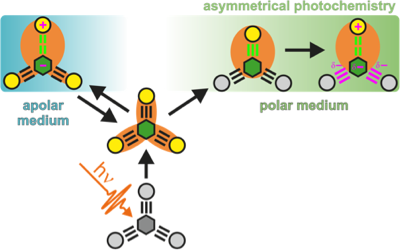-
Solvent tuning of photochemistry upon excited-state symmetry breaking
B. Dereka, D. Svechkarev, A. Rosspeintner, A. Aster, M. Lunzer, R. Liska, A.M. Mohs and E. Vauthey
Nature Communications, 11 (1) (2020), p1925


DOI:10.1038/s41467-020-15681-3 | unige:135135 | Abstract | Article HTML | Article PDF | Supporting Info

The nature of the electronic excited state of many symmetric multibranched donorâââ‰â¬Åacceptor molecules varies from delocalized/multipolar to localized/dipolar depending on the environment. Solvent-driven localization breaks the symmetry and traps the exciton in one branch. Using a combination of ultrafast spectroscopies, we investigate how such excited-state symmetry breaking affects the photochemical reactivity of quadrupolar and octupolar A(-Ãâ¬-D)2,3 molecules with photoisomerizable A-Ãâ¬-D branches. Excited-state symmetry breaking is identified by monitoring several spectroscopic signatures of the multipolar delocalized exciton, including the S2ââ S1 electronic transition, whose energy reflects interbranch coupling. It occurs in all but nonpolar solvents. In polar media, it is rapidly followed by an alkyne-allene isomerization of the excited branch. In nonpolar solvents, slow and reversible isomerization corresponding to chemically-driven symmetry breaking, is observed. These findings reveal that the photoreactivity of large conjugated molecules can be tuned by controlling the localization of the excitation.

